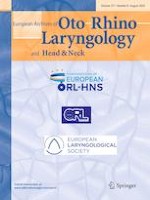Erschienen in:

06.04.2020 | COVID-19 | Rhinology
Zur Zeit gratis
Olfactory and gustatory dysfunctions as a clinical presentation of mild-to-moderate forms of the coronavirus disease (COVID-19): a multicenter European study
verfasst von:
Jerome R. Lechien, Carlos M. Chiesa-Estomba, Daniele R. De Siati, Mihaela Horoi, Serge D. Le Bon, Alexandra Rodriguez, Didier Dequanter, Serge Blecic, Fahd El Afia, Lea Distinguin, Younes Chekkoury-Idrissi, Stéphane Hans, Irene Lopez Delgado, Christian Calvo-Henriquez, Philippe Lavigne, Chiara Falanga, Maria Rosaria Barillari, Giovanni Cammaroto, Mohamad Khalife, Pierre Leich, Christel Souchay, Camelia Rossi, Fabrice Journe, Julien Hsieh, Myriam Edjlali, Robert Carlier, Laurence Ris, Andrea Lovato, Cosimo De Filippis, Frederique Coppee, Nicolas Fakhry, Tareck Ayad, Sven Saussez
Erschienen in:
European Archives of Oto-Rhino-Laryngology
|
Ausgabe 8/2020
Einloggen, um Zugang zu erhalten
Abstract
Objective
To investigate the occurrence of olfactory and gustatory dysfunctions in patients with laboratory-confirmed COVID-19 infection.
Methods
Patients with laboratory-confirmed COVID-19 infection were recruited from 12 European hospitals. The following epidemiological and clinical outcomes have been studied: age, sex, ethnicity, comorbidities, and general and otolaryngological symptoms. Patients completed olfactory and gustatory questionnaires based on the smell and taste component of the National Health and Nutrition Examination Survey, and the short version of the Questionnaire of Olfactory Disorders-Negative Statements (sQOD-NS).
Results
A total of 417 mild-to-moderate COVID-19 patients completed the study (263 females). The most prevalent general symptoms consisted of cough, myalgia, and loss of appetite. Face pain and nasal obstruction were the most disease-related otolaryngological symptoms. 85.6% and 88.0% of patients reported olfactory and gustatory dysfunctions, respectively. There was a significant association between both disorders (p < 0.001). Olfactory dysfunction (OD) appeared before the other symptoms in 11.8% of cases. The sQO-NS scores were significantly lower in patients with anosmia compared with normosmic or hyposmic individuals (p = 0.001). Among the 18.2% of patients without nasal obstruction or rhinorrhea, 79.7% were hyposmic or anosmic. The early olfactory recovery rate was 44.0%. Females were significantly more affected by olfactory and gustatory dysfunctions than males (p = 0.001).
Conclusion
Olfactory and gustatory disorders are prevalent symptoms in European COVID-19 patients, who may not have nasal symptoms. The sudden anosmia or ageusia need to be recognized by the international scientific community as important symptoms of the COVID-19 infection.











